People On The Move
From ancient past to global present, us humans are a migratory bunch. But with climate change redrawing maps of the world, what does the future hold? Plus, the science behind Pfizer’s coronavirus vaccine announcement, and what they’re not yet telling us; the mink farms that are spreading a new variant of COVID-19; and the UK scientists trying to extract oxygen from the moon...
In this episode

01:01 - Pfizer's coronavirus vaccine: how it works
Pfizer's coronavirus vaccine: how it works
Anne Moore, University College Cork
The US pharmaceutical giant Pfizer and the German manufacturer bioNTech claim to have created a coronavirus vaccine that has "more than 90% efficacy". Their vaccine is currently in the final stage - Phase 3 - of the approval process; it’s being tested on 43,500 people in six countries; and, so far, it appears to be safe. Nevertheless, despite the hype and hope, there is still an enormous amount we don’t know about this vaccine, which works in a totally new way that’s never been tried before in humans. Anne Moore is an immunologist from University College Cork, and explained to Chris Smith...
Anne - The vaccine works by delivering a piece of genetic material into the cell. And we've been doing this since, I suppose, the mid 1990s with DNA, which is one type of genetic material; and we've always wanted to use the other type of genetic material ,which is RNA. But the big problem with it up to a few years ago was that RNA is so unstable, and it degrades very quickly as soon as you put it into the body, and it's quite difficult to get it into a cell as well. So we had to overcome those problems. So this company BioEnTech - and other companies out there as well, Modern in the US are also taking a similar approach - have changed the RNA to make it much more stable, so it doesn't degrade as easily; and they've also found this little lipid drop that you put the RNA in, so that it doesn't break down when you put it into the body, and then there's enough instructions on that piece of genetic material to drive production of the spike protein from the SARS-CoV-2 virus that causes COVID-19.
Chris - So you're putting in the genetic message corresponding to the outer coat, this spike protein, of the virus; and cells can actually read that genetic message when you inject it, and then make their own version, as though they've been infected by the virus for real?
Anne - Exactly. And the nice thing is that they haven't been infected by the virus for real, or any other virus, so the immune system can just focus on looking and responding to that spike protein from the SARS-CoV-2 virus.
Chris - Admittedly it's early days at the moment, but what do we know about the response the body is making in people who have received this vaccine and vaccines like it?
Anne - Pfizer and BioNTech published some of their phase one data, and what we know is that when it's used, you get high levels of antibodies and very strong T cell responses, which are these cells that can go around and they're like the marines of the immune system: they can kill any virus infected cells, and they can also support the correct development of antibodies as well. So it seems to be a global response overall. What we don't know very well is how much of these responses are needed to protect you from infection from SARS-CoV-2.
Chris - And how long do those responses persist for? Because that's another key question, isn't it? We can't presumably have much knowledge yet, because we've only known about the virus for under a year, and we've only had this vaccine trial going on for a matter of months.
Anne - Exactly. It is an absolutely crucial question: how long can those immune responses, those antibodies and those T cells, remain strong enough in the body to provide that protection? And unfortunately, we're not smart enough to know yet, as soon as we immunise somebody, how long that protection will last. Time is needed to see how long those immune responses stay high. I suppose the other really, really key question that we don't know at all is: what is the threshold of protection that's required? So if you need a very little antibodies or T-cell to still protect you against infection, we have more faith that these vaccines will protect you for longer; but if you need to maintain very, very high levels of antibodies and T cells, then the likelihood is that the durability of protection will wane, will you go down a bit faster than we would like.
Chris - There was enormous fanfare around the 90% number - the announcement was, "it's 90% effective" - but if you turn that round, it means it's a 10% failure, or a failure 10% of the time. But we weren't told who the 10% it doesn't protect are! And if they end up being the same 10% as the people who are destined to get severe illness with coronavirus, arguably it doesn't move us very much further forward, this vaccine.
Anne - So the 90% efficacy means: of the people that were infected, 90% were from the placebo group and only 10% were vaccinated. So it's saying that if you have the vaccine, you have a 90% less possibility of being infected. And for a lot of vaccines, that's more than sufficient. For some vaccines like measles and things like that we do need a higher protection such as 95%. I don't know of any vaccines that will give you a hundred percent protection. Plus as long as 90% of the community are protected, it provides a good barrier for the population. For somebody who works in vaccines, 90% protection is good. We're happy with that. It's a good response.
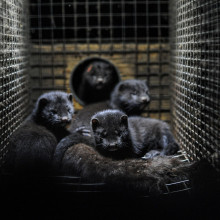
06:39 - Mink infect 12 with new coronavirus variant
Mink infect 12 with new coronavirus variant
Alina Chan, Broad Institute
Since July, over 200 people in Denmark have been infected with versions of the coronavirus that have been spreading through mink farms. Farmers likely transmitted it to the mink, where it has mutated in different ways; and recently scientists confirmed that some of these mutants have jumped out of the mink and back into humans, and then possibly also between humans too. The worry is that these mutations could render the infection resistant to the vaccines we’re developing. Alina Chan is a scientist from the Broad Institute in the US who has been tracking coronavirus mutations, and explained to Phil Sansom how she sees the situation...
Alina - In Denmark they have more than 1100 mink farms. More than 200 have been found to have COVID-19 outbreaks. And now that virus that has been circulating among the minks has passed back into the human population in Denmark.
Phil - Wow. You know, I wouldn't have put minks as top on my list of COVID threats.
Alina - Yeah, this is not too surprising, although it's really devastating to hear this news. That's because we have known for a while - scientists have known for a while - that SARS-type viruses can infect ferrets, which are in the same family as minks. And so it's not surprising that minks are susceptible to SARS-2.
Phil - So is this the first time that minks have got SARS-CoV-2?
Alina - No, this is not the first time that this whole scenario of transmission from humans, to minks, to humans has been observed. As of today, there are at least six countries that have reported these mink outbreaks. So we've got Denmark; but the first was actually the Netherlands, and they were the first to report a mink outbreak back in April of this year.
Phil - Do we know what happens to the virus when it's in the minks?
Alina - This part is kind of a mystery, pr I'd say at least an ongoing study. There were two publications that just came out. One of them is by the Dutch group; there are a few caveats in their approach, but they said that they see some hints of faster evolution of the virus in the minks. More analysis needs to be done, and by independent groups of scientists. The other publication is by the Danish group, but this is a working paper, and so they have not shared their mink genomes yet; although they have committed to the WHO that they will.
Phil - So we don't have the full picture then of what the virus looks like in the minks. But am I right that we do know what the virus looks like once it's left minks and is back in humans again?
Alina - Yes, we can see what could be the mink associated variants coming out back into the human population in these two countries as well. In Denmark there's one cluster that is particularly concerning; it's called Cluster 5. A cluster is a group of SARS-2 sequences, in this case, that look really similar to each other. This cluster has a combination of different mutations in the spike gene; this is what helps it to infect different host species, and it's also the target of some of the most potent therapeutic antibodies.
Phil - What are the mutations?
Alina - They see about three to four different mutations. And actually each one of them has been around since at least March, across many countries and continents. So the individual mutations, they are not novel, but as a combo, they're novel. But they found that the most recent mutation, I692V... no other country in the world has detected it, and it only appeared in August.
Phil - I mean… what's the implication?
Alina - According to the Danish paper that came out, they got convalescent plasma from patients, and they found that in some of the cases, the plasma was not able to neutralise the new mink associated variants. And so now they are a bit worried that this could have an impact on antibody therapeutics, or vaccines in development. But again, just to emphasise the effect that they saw, it's not that drastic, but it does suggest that people who don't have long lasting immunity could be susceptible to this new variant.
Phil - So what's your take? Is the virus now more dangerous that has gone through minks?
Alina - I don't know. I think that's the answer that most scientists would tell you, is that we just don't know. I don't think people should panic. When I say mutations, it doesn't mean that every single mutation makes these viruses more transmissible, or more dangerous for humans. Not at all. In fact, many of them could actually be taking a step backwards, considering that they are adapting to a different animal species. What the worry here is besides from these mink farms being a pool, they are generating more diverse viruses. So if these different variants, even if some of them are weaker in humans, if they enter the human population again, and we start implementing a widespread vaccination, for example, this will select for those rare variants that vaccines don't work as well against.
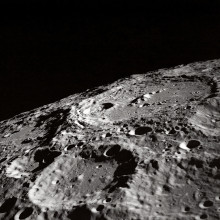
11:26 - Moon dust: ESA contracts firm to extract oxygen
Moon dust: ESA contracts firm to extract oxygen
Ian Mellor, Metalysis
This week a British firm announced that they’d won a European Space Agency contract to develop technology to extract oxygen from dust. But not just any dust - Moon dust. Katie Haylor reports...
Ian - We've been contracted to extract oxygen from moon dust.
Katie - That's Ian Mellor, managing director of Metalysis, a British company who specialise in producing metal powders through a process called electrolysis. Electrolysis uses an electric current to separate ionically bonded substances; in this case, moon dust's metal oxides, so metals and oxygen.
Ian - 50% oxygen and 50% metals; typically aluminium, iron, titanium. Our process is an electrochemical process. There are two electrodes; the cathode is the moon dust. You apply a small voltage between the two electrodes. The oxygen is moved from the moon dust, it goes through a conducting electrolyte, it reaches the anode and it is gassed off as oxygen, and leaves the metal powder that can be used for making structures.
Katie - Metalysis have recently been awarded a contract from the European Space Agency to get their chemical process working on the moon. And out there on the moon, it's actually the oxygen from moon dust that they're primarily interested in.
Ian - On Earth the oxygen is a waste byproduct. In a moon context, the oxygen is that the key product. It can be used as a fuel or a propellant; it could be used for breathing to sustain life and activity on the moon.
Katie - It's a rather exciting time in the world space exploration at the moment; although when isn't it, to be honest. But the backdrop to this particular story is NASA's 2024 Artemis program to return to the moon. One key component of this mission is to actually build a base at the lunar South pole to support longer expeditions to the surface. And a plentiful supply of oxygen is critical if we're to support people up there. What's more, Ian reckons this oxygen could be helpful as a fuel. In fact, in an interview with the Guardian, he described the idea as a bit like a lunar petrol station that craft could one day use before making their way out to deeper space. So what's so special about this particular process? Why work towards having this technology on the moon?
Ian - The moon dust is always in the solid state, so there's no dissolving. Whereas in other processes you would actually dissolve the moon dust. It allows us to do the process much more efficiently. There's no need to melt, which is normally associated with high temperatures.
Katie - Less energy required means the process becomes more efficient, which is reassuring, as energy might be at quite a premium when you're not hooked up to the earthly grid.
Ian - The process operates around 900 degrees C. Solar cells provide the electrical energy we would need for the electrolysis.
Katie - And adequately powering this process isn't the only thing to consider when trying to do chemistry on the moon. They're working to get it automated so it wouldn't need a whole lot of human supervision to get on with its task, but there are other practical challenges to consider.
Ian - The questions that we're looking to answer: gravity being one; very dusty environment, the moon, and you don't want to get dust into your equipment; it needs to be a small and as light as possible.
Katie - And what about sustainability? If we're mining on the moon, is it just going to be left with a bunch of holes in it?
Ian - We can actually take the surface moon dust, so we don't need to send out drilling equipment, we don't need to be intrusive. Once you've extracted what you need, what you don't need you can put back and make good.
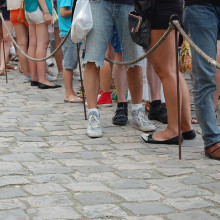
16:24 - Slovakia's mass testing: a success?
Slovakia's mass testing: a success?
Beata Balogová, SME daily
Last week we explained to you how mass coronavirus testing was kicking off in Liverpool, one of the UK's cities hit hardest by the pandemic. The goal is to screen all 500,000 people who live in and around the city, and isolate those who test positive. It's an attempt to get on top of the problem that more than half of coronavirus cases have no symptoms and are therefore being missed by the present testing process. It's also potentially a dry run for testing the entire UK population at a later date. One country that have already had a stab at this over the last two weeks is Slovakia; Beata Balogová is the editor in chief of Daily SME, one of the country's major news publications, and Chris Smith heard what she made of it…
Beata - First, the whole country was tested a week ago. The reason was that the government got quite nervous about the state of hospitals, and they thought that it's a good idea to test the entire population to see how widely spread the virus is. And then they repeated a second testing for those regions which came out as the most infected in the first day of testing
Chris - And people who were tested, what was then done to them? If they got a positive result, how was their case handled?
Beata - They had to self isolate for 10 days, but perhaps it's interesting and important to say that even people who refused to undergo testing, they had to self isolate. So it means that the testing wasn't voluntary as the government stated originally, but they wanted to make sure they isolated a large mass of people who either refuse to undergo testing, or have a positive test result.
Chris - There's about 5 million people in the country, in Slovakia, is that right?
Beata - Yes, it's slightly above 5 million.
Chris - So how did they do testing at that sort of scale; and not once, but twice?
Beata - First, they managed to test 3.6 million people, and they were able to do it only with the help of the army, and the willingness of physicians and healthcare employees. Logistically, it was a very huge and demanding thing and it's a great strain on healthcare.
Chris - What was the reaction of the population? How did the population react to being told, "this is what we're going to do"?
Beata - They were quite disciplined. Part of the population was frustrated by the fact that it's claimed to be voluntary, but it wasn't. They just had to undergo the testing, because otherwise they would not be able to go to work, even to do normal shopping, because now even shop owners are entitled to ask for a certificate that you were tested negative. During the actual testing they were surprisingly disciplined. And at some places there were three hour queues and people were lining up, and really waiting patiently to get tested.
Chris - Out of a country with about 5 million people, if three and a half million-ish got tested, what's happened to the other one and a half million? Were they objectors who didn't want to get tested, or were they just lost to follow up?
Beata - Some of them were elderly - the government said that they did not recommend people over 65 to undergo testing, unless they really needed to move around - but also there are people who simply didn't undergo the testing. And during the second testing, they tested 1.8 million people, and these were the people who are from the affected regions from the north.
Chris - And what's been the outcome of doing these two sets of testing? And what are they going to do now to try to keep a lid on things?
Beata - Well, if we don't want to trust the government - which is saying it's a big success, and that basically they managed to push down the infection rate by 58% between the two testings - we really have to wait for what the experts say. However, on the daily infection rates, which we are getting, we can see a slight drop; but you cannot really tell if it is because of the government measures, or if it is really the result of the testing. So we will have to wait a couple more weeks to really be able to say that if it is a good idea - turning your country into a laboratory.
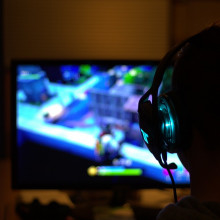
21:12 - EVE Online: gamers analyse COVID data
EVE Online: gamers analyse COVID data
Jesse “Nobutadas”; Ryan Brinkman, University of British Columbia; Páll Grétar Bjarnason, CCP Games; Jérôme Waldispühl, McGill University
All sorts of people have been getting involved in the battle against COVID, and now there’s a new posse in town - computer gamers! They’re helping out via a project that gets players of a massively popular online spacefaring game to solve puzzles as they play and identify immune cells for scientists trying to study the body’s response to the coronavirus. Eva Higginbotham reports…
Jesse - EVE is a difficult game to describe. You can be a space pirate that goes around stealing or killing other capsuleers in the game. You could be someone who does industry, where you look at the markets, or you mine your own materials, and then you build stuff for other players to use, other players to go blow up, or even yourself. You can be a trade mogul where...
Eva - That's Jesse, an avid player of a game called EVE Online, where as you just heard, you can live out a whole complex life in space. But now while you're absentmindedly mining for resources, or waiting to go through a wormhole, there's a new activity to get your teeth stuck into: analysing data from studies on coronavirus as a part of Project Discovery. Ryan Brinkman explains.
Ryan - The first and probably the most important thing is: we're trying to help scientists in the fight against COVID. So one of the technologies that's being widely used is flow cytometry. What we use flow cytometry for is to look at the different cells that are present in our blood, the white blood cells that are used to both detect infection and to fight infection. We take a sample of a patient's blood, and we label the cells so that they glow with light when they run past the laser one by one. What we label these cells with is on proteins, on the cell surface that we know define the function of these cells.
Eva - These protein markers act as signposts to scientists, telling them what kind of cells are present in a patient's blood. This is important because when your body mounts an immune response to something, a lot of different types of white blood cells get involved, and understanding which immune cells are prevalent, and in what proportions, tells scientists loads of information about how a patient is responding to an infection like coronavirus or a treatment. Scientists can now label up to 50 different proteins on the surface of these cells at the same time. But despite the power of this technique, the thing is...
Ryan - Flow cytometry data analysis sucks. We have 50-dimensional data that scientists are trying to look at. It's just really hard to traverse through this data, when scientists are limited by a two dimensional computer screen, to try and find the cell populations that are important.
Eva - Essentially, flow cytometry analysis is time consuming and laborious. It involves drawing shapes around clusters of dots, where each dot represents an individual cell from a patient's blood; and trying to decide if this dot is a part of that cluster, or is it in its own cluster, or maybe that one, you get the idea. And the fact is, it's currently just too complex and subjective to get a computer to do it all for us. After all, humans have evolved to be very, very good at seeing patterns.
Ryan - People who didn't catch patterns very well were all eaten by saber-toothed tigers millions of years ago, right?
Eva - So what Ryan and his team have done is broken down the 50-dimensional data into lots of two-dimensional puzzles. And that's where EVE Online comes in. These 2-D puzzles are prettied up and uploaded into the EVE Online world, where players can access them as a part of a mini game, like a side project to the main business of hunting down enemy spaceships. And the more puzzles you solve, the better rewards you get within the game. Obviously, I had to give it a go, under the supervision of Páll Grétar Bjarnason, who works with a company that makes EVE Online…
I've actually set myself up with an account, I've made my character, I've got a spaceship. So what I'm looking at is basically...
I could see a sort of graph with an X and Y axis. And there were all of these different coloured dots on the screen. Where there was a high density of dots in a section of the graph, they were all coloured red. And then in lower density, they were blue or violet, like a heat map. Each of these dots is an individual cell. And by separating out the clusters, you're sorting out the cells into potentially different cell types. The tricky bit though is deciding where one cluster stops and another begins…
So using my mouse. I'm just now drawing sort of, lines around what looks like sort of an epicentre of dots. How am I doing with my lines?
Páll - I think you're doing pretty good so far.
Eva - Okay, great. I'm going to hit submit, see how I did. Ah, passed! Well, it says I'm now a trainee data analyst, so I'm pretty pleased with that result…
So it's all fun and literally games, but this is also a great example of what's called citizen science. Jérôme Waldispühl, another lead on the project.
Jérôme - Citizen science is the process of involving the population into the scientific discovery process. And that's what we're doing for the Project Discovery project.
Eva - And it's not just about getting more people involved in science. Having this many eyes on the same data means that the results of the analysis are more robust, and also means that the data can be explored in a much deeper way than if scientists were doing it all on their own.
Ryan - We have really, one-on-one collaborations with many of the scientists providing the data. And they're really, honestly, very excited about the results that the players have to have.
Eva - And it's also great for Ryan and Jérôme's teams, because just in the last few months since the project began they have received over 48 million individual pieces of flow cytometry analysis, which is an excellent basis for them to train artificial intelligence algorithms on how to do this analysis automatically. And with over 170,000 players contributing so far, that number is only going to get bigger. Jesse.
Jesse - I encourage everyone, even if you've never played EVE Online, and you want to contribute something to the coronavirus research, to give it a try. It's got some really cool graphics on to show how the flow cytometry works. It's very simple, easy, fun, and therapeutic to get involved with.
Eva - And for Jérôme, it's about more than flow cytometry, more than training algorithms... more even than coronavirus itself.
Jérôme - Because ultimately, what you want to do is to show people that doing science is not that complicated. Actually, it can be fun. Doing it through a game allows you to remove this mental barrier we put for ourselves at contributing to science, and when you start doing it, you realise that you can make a difference, and we can move forward all together toward this science-based society.
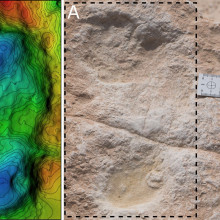
28:40 - Ancient human footprints discovered in Arabia
Ancient human footprints discovered in Arabia
Mathew Stewart, Max Planck Institute for Chemical Ecology
We’re 'anatomically modern' humans - Homo sapiens - and our species arose about 250,000 years ago in Africa. At some point, our ancestors left the continent to spread across the rest of the world. Previous fossil and other evidence suggested that this began to happen from about 55,000 years ago, although the science was shaky. That’s why the recent discovery of a cornucopia of fossilised footprints in Arabia, which is of course outside of Africa, and dating from a hundred thousand years ago, is a huge step forward in our understanding. The tracks include ancient elephants, horses, and what appear to be modern humans. Mathew Stewart is one of the discoverers, and spoke to Chris Smith...
Mathew- What makes these findings in particular special is the age of the deposits, I would say. We dated the footprints to around about 125,000 years ago. This was a particularly humid period, and it's quite an important period for human dispersals out of Africa.
Chris - Can you tell us a bit about the area you were working in when you made the discovery? What does it actually look like today?
Mathew - This is one of the largest deserts in Arabia. So you can picture - very, very arid, little in terms of vegetation and animals, and just rolling sand dunes.
Chris - And when you went there, obviously you didn't go there anticipating you were going to find an amazing collection of footprints. So what did you expect to find?
Mathew - The footprint findings were sort of quite a lucky finding. We were surveying a palaeo lake - so an ancient lake deposit - as we've done hundreds of times in this area. And in this instance, we had happened to notice that the surface of the palaeo lake was covered in these footprints and trackways.
Chris - It must've been pretty exciting for you when you realised what you'd stumbled on.
Mathew - Yeah, it was, it was very exciting. In fact, we were at the sight for quite some time before one of our senior colleagues noticed the footprints. And as soon as we saw a couple of them, we realised that the entire ancient lake surface was covered in them.
Chris - And how do you know how old they are?
Mathew - The footprints were being exposed by the erosion of these overlying lake sediments, but there were still some of those overlying sediments left. So we were lucky enough to be able to date the sediments below and above. And so we used this method known as optically stimulated luminescence dating, targeting these layers, which led us to conclude that the footprints were between 121-112 thousand years old.
Chris - And who made the footprints?
Mathew - We argue that these are footprints made by our species, Homo sapiens, on two grounds. There is no evidence for Neanderthals in that region at that time. What we do know is that we have Homo sapiens dispersing out of Africa at around about that time. The second line of evidence is the size of the footprint. So we did some stature and mass estimates based on the footprints themselves and compared those to estimates of Homo sapiens and Neanderthals based on fossilised bone. They come out more closely to Homo sapiens.
Chris - Critically though, when for years we've been talking about how humans left Africa - because we agree that anatomically modern humans like us almost certainly had their origins on the African continent, and that's based on a whole range of different lines of evidence isn't it, including genetic evidence - we've been telling people as a community scientifically for years that the exodus out of Africa to populate the rest of the world seems to be around about 50-60 thousand years ago. But you're pointing to a different geography from Africa, and you're pointing to a timeline 60 thousand years earlier. So does this then suggest that actually we had it wrong?
Mathew - Yeah. This sort of joins a growing corpus of evidence suggesting that this traditional view of this exodus out of Africa at around 50 thousand years ago isn't entirely correct. There is growing both archaeological and fossil evidence to suggest that we dispersed out of Africa earlier, all the way to Northern Australia by around about 65-70 thousand years ago. The picture is just becoming much more complex. It appears that we left multiple times; that there were dispersals back into Africa; it's adding to this much more complex picture.
Chris - And presumably if these footprints were in what is now a dried up lake, it was once not a dried up lake. And it presumably then was not in a desert. So what was the environment there like, and does that point towards why these early humans could have been making a beeline for that geography?
Mathew - Absolutely. The Arabian peninsula, much like the Sahara, wasn't always the hyper arid desert that they are today. And in fact numerous times over the past million years the conditions have changed drastically, during what are known as interglacials - quite humid periods. The last interglacial, which is what the footprints date to, being one of these very humid periods; changing the Sahara and Arabian deserts into big open grasslands, large permanent rivers and lakes, and vastly different flora and fauna as well.
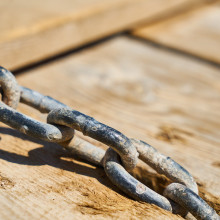
33:52 - The transatlantic slave trade's genetic legacy
The transatlantic slave trade's genetic legacy
Steven Micheletti, 23andMe
Let’s jump forward a hundred thousand years to what might be the largest movement of people in recorded history: the transatlantic slave trade. For hundreds of years, people were taken from Africa across to the Americas, leaving an enormous legacy on our world today. The slavers kept thorough shipping records, but for historians, it’s always unclear whether they’re seeing the full picture. That’s why geneticists from the company 23andMe have been poring through the genes of people in the Americas today, and checking to see if their genetic ancestry to parts of Africa matches the historical records. Steven Micheletti from the team explained their findings to Phil Sansom...
Steven - Billions of people have been directly moved by slave trades over the course of human history. But the largest slave trade in recent history - the transatlantic slave trade - was this triangular trade between Europe, Africa and the Americas where one of the commodities happened to be human lives. During this event between the 16th and 19th centuries, historians estimate about 12.5 million Africans were taken and forced across the Atlantic. But it's important to note that only about 10 million of these enslaved people survived the voyages.
Phil - 10 million people is a lot to have on your plate still though. So how did you go about looking into this?
Steven - Our team started by reviewing the history of the transatlantic slave trade through studying slavevoyages.org, which is this digital compilation of about 35,000 transatlantic shipping manifests. And so for economic purposes there were these detailed records kept which documented each enslaved person taken from Africa. So we looked at those records, and such variables as the number of individuals taken from each region of Africa, and where in the Americas these individuals were being taken to, and other variables like men, women, and children being taken. And so that's on the historical record side. But we're of course experts in genetics. So we wanted to actually look at the genetics of people across the Americas, and we're fortunate to have 50,000 study participants across the world today, willing to share their DNA for this research. We specifically looked at genetic data from these participants today who have African ancestry, and we traced their DNA back to populations across Africa to see if their genetic connections match the estimates from shipping manifests. Just to give a quick example, if more people were taken from the Congo region of Africa and brought to say, Brazil, does this mean that Afro-Brazilians today have strong genetic connections to populations of the Congo?
Phil - Broadly then, when you're looking at these two lines of evidence, do they seem to match up?
Steven - Broadly? Yes. In most regions of the Americas, there was a strong correlation between the strength of genetic connection with an African population and the number of individuals taken from that population during the slave trade. For instance, the majority of enslaved people forced into parts of the Caribbean were from tribes of Nigeria and consequently people in the Caribbean today tend to have the strongest genetic connections with tribes of Nigeria. And that's common in many of the countries we looked at, but it wasn't always the case.
Phil - I mean, you emphasised the word broadly when you started that answer, which makes me think that there are some places where you found little mismatches. Is that true?
Steven - Yes. And there's, there's definitely a lot of discordances that we came across. And let me give you examples of two broad disagreements. One is, by far the most enslaved people were taken to Latin American countries. Compare 400,000 enslaved people that were brought directly to the US from Africa versus about 4 million that were brought directly to Brazil. And our expectation then is because so many Africans were brought to Latin America, there should be more African representation there. However, we found the opposite to be true. People of African descent from Latin American countries tended to have the least amount of African ancestry. So that was a big surprise.
And then the second broad disagreement was that mostly men, according to the records, were enslaved during the transatlantic slave trade. But we have genetic evidence that people of African descent tend to have inherited their African ancestry from their maternal side. So in other words, African women were estimated to have been reproducing more than African men.
Phil - Have you got any way to explain that? Because that seems like a weird couple of blips to have in your data.
Steven - For one, we found that there were different national ideologies and different ways of treating enslaved people between Latin American countries and other countries. Latin American countries tended to work their enslaved people to death. And because of this, enslaved people weren't having many children and weren't able to pass on their African ancestry. And therefore there's not a lot of African representation today. In terms of the African women reproducing at higher rates, this matches up with the known accounts of rape and exploitation of African women over time, where basically African women were forced against their will to reproduce.
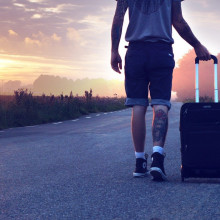
39:32 - Humans in period of unprecedented mobility
Humans in period of unprecedented mobility
Oli Brown, Chatham House
More people are on the move nowadays than ever before. The climate is changing, but the world is also becoming more globalised and urbanised. Oli Brown is a former UN migration expert who now works for Chatham House, and took Chris through the different factors...
Oli - It might not feel like it with 2020 and COVID lockdowns, but we live in a period of unprecedented mobility. 750 million people are migrants within their own countries, typically moving from rural areas to urban areas, and another 250 million people live outside the country of their birth. So collectively, globally, that's one in eight people are migrants. And it's a hugely important driver of development - it spreads ideas, connects the world, offers opportunity to individuals and families - but there are also millions of people who've been forced out of their homes and off their land as refugees or displaced people.
Chris - And who are we actually talking about here? And where, specifically?
Oli - It varies around the world. So two thirds of all refugees at the end of 2019 came from just five countries: Syria, Afghanistan, South Sudan, Venezuela, and Myanmar. But all of those people who are displaced by natural disasters and industrial accidents, again, that can happen all around the world. Numerically India, the Philippines, Bangladesh, and China have the most people who are displaced by disasters in 2019; but it's not just countries who you might think of being as being a little bit poorer that have this. The fifth on that list is the US.
Chris - And if we wind back the clock a bit, we began this part of the program with that wonderful story of those footprints in Arabia, a hundred thousand-plus years ago, and those individuals were lured there by what we were told was an oasis at the time; it wasn't a desert then. Are the same sorts of factors luring people across the Earth today, or equally pushing them away from their homeland?
Oli - Yeah, absolutely. I think people have always moved, as we heard, in response to the climate, and to find better living conditions elsewhere. What's different now is that the speed and the scale of the change has accelerated so much, and that humans are the root of the changes we're seeing. Basically human activity has changed the environment, and reshaped the environment so significantly that many scientists agree that we've entered what they're calling a new geological epoch, the Anthropocene. And just to give you some examples: since pre-industrial times the amount of carbon dioxide in the atmosphere has increased 50%; human activity now moves three times as much earth every year as all of the world's rivers combined; and we're on track to have more plastic than fish in the oceans by 2050. So human activity is redrawing the map of the world. It's redrawing where rain falls; where you can grow crops; how hard storms, droughts, and floods hit. And that's having a real impact on where people can live.
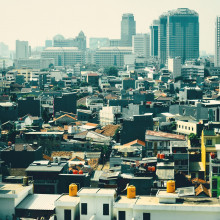
42:36 - Jakarta is sinking. Who has to move?
Jakarta is sinking. Who has to move?
Kian Goh, UCLA
Indonesia are currently planning to move their capital city from Jakarta to a proposed city that doesn’t yet exist! This isn't the first time this has been done - for example, Brazil constructed its capital Brasilia as a planned city in the 50s - but the environmental pressures here are new. Because according to UCLA planning expert Kian Goh, Jakarta is literally sinking into the sea! Kian explained to Phil Sansom...
Kian - Jakarta floods chronically. It floods every year, and every five to seven years or so there's a massive inundation that covers about a third of the city. And this flooding is getting worse because of rapid and severe land subsidence; parts of the city are literally sinking at up to about 10 centimetres a year. And this sinking is primarily caused by the overpumping of groundwater, which leads to soil compaction. This is made worse by rampant urban development, where we see more and more of the ground in the city covered by asphalt and concrete, leaving less and less permeable surfaces for rainwater to seep back in. The ground is sinking, and it is also becoming less permeable. On top of that, because of climate change, sea levels in the Jakarta Bay are rising; and precipitation is becoming more and more uncertain due to these factors. And so all this is basically a recipe for catastrophic flooding in a city that already faces other long term problems such as congestion and stark inequality.
Phil - Given such a perfect storm of horrible factors that you described, are Indonesia planning to move everyone in Jakarta to a different place? And if not, what are the people left behind... what are they going to do?
Kian - That is a key question, a really excellent one, because I think many people assumed that they would, like, pick up Jakarta and move it to another island; and that's just not the case. Jakarta is a city of about 10 million people in the capital district proper, and it's been the centre of economic growth in the country and region since Dutch colonial times. So if the national government does build a new capital on the island of Borneo as it plans, it will certainly move the administrative and political functions of the national government, along with some services and support functions. But Jakarta will remain the population and economic centre of the country for the foreseeable future. And so what happens in the city? It's projected that about four and a half million people live in places that will face catastrophic flooding around 2030 or so. And many of these are poor urban residents who live in the informal 'kampung' settlements; these are essentially urban villages along rivers and canals, and along the coastline. Many of them may well have to move, not necessarily to a new city, but towards more safe and sustainable living conditions within the city. And the big question really is how the city, whether or not it's the seat of national government, addresses the flooding problem in a way that is just and equitable for its most vulnerable and marginalised residents.
Phil - Over the next, what, 50-100 years, we're projected huge amounts of sea level rise. I can't remember the figures, but something like up to seven meters at the worst estimate. In that situation you need a little bit more than better living conditions, so what are people going to do?
Kian - Well, the city has been trying various plans, including ongoing efforts to dredge and widen the canals and rivers, as well as much more ambitious plans. Some years ago, city officials along with a group of Dutch consultants proposed a large scale master plan, also known as the 'Giant Sea Wall'. In its most ambitious iteration when it was proposed, it called for essentially a new city, shaped like a garuda - which is a mythical eagle that is the national symbol for Indonesia - to be built on landfill in the Jakarta Bay. This new city would create massive retention ponds behind it, between the Sea Wall city and the existing city, that could be pumped low enough so that the rivers and canals in the city drain into it. And this ambitious plan has faced a lot of protests, often by poor urban residents who live along the coastlines, who are afraid that such a plan would destroy the mangroves, destroy the fisheries, and displace them. More recent iterations have really trimmed down its grand ambitions, and the city still hopes that some of these initiatives will address the worst of the flooding in the coming years. But as you say, when we think about 50-100 years down the line, we need to do more than that.
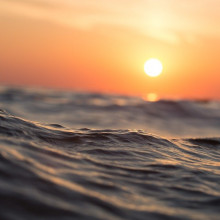
48:01 - The future of human migration
The future of human migration
Oli Brown, Chatham House
We’ve heard about the future Jakarta faces - and these problems apply to the rest of the world too. In fact, the World Bank has looked into the numbers of ‘climate migrants’ we might see in three of the poorest regions of the world, and said we might expect 140 million by 2050. Chris Smith asked migration expert Oli Brown what the future looks like...
Oli - That's a huge question. I mean, we're in the middle of a massive demographic change, with a shift towards urbanisation; already half the world live in urban areas, by 2050 that's going to be two thirds. The World Bank estimates that the number of people who might be displaced as a result of climate change could be 140 million by 2050; some people say 200 million. There's a whole series of changes happening in where people can live. Broadly, the people who are going to move are going to be poor people in vulnerable places: so people in coastal cities; people who are living in delta areas like the Nile Delta, the Mekong Delta; or small island states like Tuvalu or Kiribati that are only a metre or two over sea level already. But pretty much everywhere is affected. Large parts of Southern Florida, for example, could be underwater by 2050. And the US government is already starting to move some of the most exposed people out of harm's way.
Chris - I was just going to ask you that, because obviously the US is a very developed economy; the UK is a very developed economy, with the capacity to do forward planning; are all countries thinking the same way though, or are there some countries that are living a bit hand to mouth, and they don't have a future plan? And what's going to happen to them?
Oli - Well, absolutely. It really depends what you can put in place in terms of how you can plan around this. The Netherlands can put in place a very effective system of dykes and flood defences to stop the large parts of the country that are already under sea level... but other countries like Bangladesh, for example, can't do that. And actually, perhaps even counter-intuitively, some of the poorest and the most vulnerable people may not even be able to move, because they simply aren't able to get away. They're forced to make do where they are.
Chris - And is there a kind of a global plan in place, so that when a particular country is underwater, those people are going to get displaced, they have to go somewhere... or people just thinking, "well, we'll worry about that when it happens"?
Oli - There's plans at all sorts of different levels. The president of Kiribati, for example, bought land in Fiji in 2014 to potentially translocate the population to another country, effectively. Every country in the world is pretty much starting to think about how climate change affects them, affects their economy, affects their ability to manage. And then at a global level, 150-odd countries signed something called a Global Compact for Safe, Orderly and Regular Migration in 2018 that is trying to put in a global plan for how to deal with these issues. But it's voluntary, it doesn't have any teeth; it's a series of good ideas, but as you were saying, the devil is in the detail.

51:17 - QotW: How does a surname multiply?
QotW: How does a surname multiply?
What's in a name? Eva Higginbotham’s been crunching the numbers to figure out an answer to this question from Beata...
Eva - I am the proud participant in a Facebook group called ‘The Family Higginbotham’ which boasts 1.8 thousand members with the tagline ‘We’re all cousins somehow’. People are always posting their latest detective work, tracing Higginbothams back through the ages, but could we do the reverse as Beata suggests, and instead project forwards to see how many people could have our name in the future? I put the question to maths whiz James Grime
James- This was a question of great interest to the Victorian nobility, who were very keen to know whether their grand noble names would live on or die out. So, let’s start with a quick calculation. And to do this, we will treat surnames in the traditional sense, as something passed from father to son. Of course, this is not necessarily true, but allows us to perform a calculation based on the average number of male children.
Eva - Now, in the 1800s, the average number of children per family was 5. Unfortunately, 2 or 3 children typically did not reach adulthood. Later, as the infant mortality rate decreased, so did the fertility rate.
James - For the sake of the maths, we have to use an average - so let’s say the average number of children has been a steady 3 children per family. Or about 1.5 male children. That means, for each generation, the number of males increases by 50%. And over 300 years, say 10 generations, the male population would grow from 1 individual to 58. Of course, I used an average here. If instead, each generation had three boys, then the number of descendants sharing that surname could be as large as 59000. On the other hand, a couple of generations with no male children could lead to the surname dying completely.
Eva - And it was the potential dying out of their surname that the Victorian nobility were concerned about. So, two great Victorian statisticians, Francis Galton and Henry Watson, decided to investigate the problem.
James - And they determined that a surname would ultimately die out if the average number of male children was less than or equal to 1. That might sound obvious, because that means the average number of males would be decreasing with each generation. But now they could show that this was a mathematical guarantee. Now, family names are actually more complicated than that. But these ideas can be used in tracing something that is passed from father to son, which is the Y-chromosome. Or equally, something inherited from our mothers, such as mitrochondrial DNA.
Eva - That means that by my calculation, in 10 generations, we could have 106,288,200 Higginbothams… yes, yes, plenty to start the master plan...oh! What? Oh yes, thanks James. And next week we’ll be looking into this question from Robyn:
Robyn - I often wonder when I listen to music in the car when my dog is with me: since they hear higher frequencies than humans, do they also perceive for example loud music louder than us?
Related Content
- Previous Mario Kart Live: Home Circuit
- Next Asteroids and Artemis










Comments
Add a comment